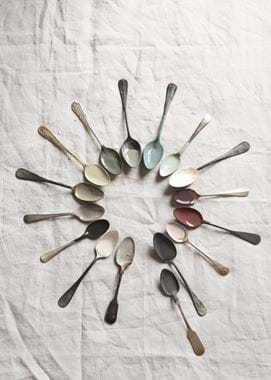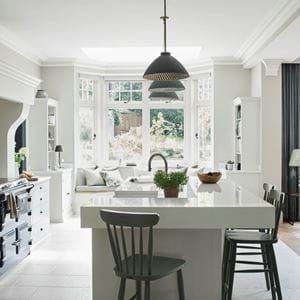Paint the spectrum: colour theory for your home
Paint the spectrum: colour theory for your home
What exactly is ‘colour theory’?
Some colours just go together. They look good, they feel right. But why? Colour is far from being an artistic practice alone. Science is very much at play, providing reasoning and rationale as to why certain colours work so well and why others don’t. And that’s the essence of colour theory – observing colour relationships through a scientific lens.
The colour wheel: a good place to start
The interior designer’s secret weapon, a constant feature in the stylist’s toolkit, impressive know-how for all decor aficionados out there – the colour wheel is the bedrock of colour theory and offers a visual explanation of inter-colour relationships.
Invented by Isaac Newton in 1666, he took the full colour spectrum and presented it in circle form to begin showing the different layers. It was Newton’s work with white light that brought about the discovery of the visible colour spectrum, and with his colour wheel, he dissected it further by establishing the three primary colours from which every other colour was derived.
Learning to read the colour wheel
Primary, secondary and tertiary colours
No matter which sort of colour wheel you use, all of them share the same essential layer of 12 core colours, each of which belong to one of three categories. As you probably already know, red, yellow and blue are there forming the primary colours whose appearance cannot be created by blending any other colour. Mix equal amounts of the primary colours together though, and you create orange (red and yellow), purple (red and blue) and green (yellow and blue) – your secondary colours. All of the colours that remain are referred to as tertiary colours. You’ll notice that their naming convention fuses two colours together e.g. yellow-green, red-orange. This is, quite simply, because they’re produced by combining any two primary and secondary shades in a 2:1 ratio.
Cool versus warm
Most of us know that every colour has either a warm or cool character. When choosing a palette, it’s one of the most important colour decisions you have to make early on as it will bear huge influence on your home’s ambiance.
In search of a cool colour (or receding colours, as they’re sometimes called)? Keep to the side of the wheel with greens, blues and violets. Wanting a bit of warmth? Then head to the land of reds, oranges and yellows (fireside tones also referred to as aggressive colours).
Warm versus cool isn’t always as straightforward as it sounds in practice – modern paints like ours are full of nuance. But, to give you a general idea, our Pebble, Nordic, Plant, and Smoke palettes all sit on the cool side, while Timber, Spice and Fossil would be considered warm.
It’s also worth knowing that you can absolutely mix warm and cool colours together in one palette. It’s just that the dominant colour, be it warm or cool, will set the overall tone for the room. Case in point: within our predominantly cool Plant palette, French Grey has a touch more yellow to it, making it warmer than the other three. They still all work together harmoniously though.
Hues, tints, tones and shades
So often do you hear these terms used interchangeably as a synonym for the word ‘colour’ (which is fine as, colloquially, they’ve come to mean much the same thing). But in colour theory, it’s only ‘hue’ that qualifies as an alternative. The rest have very different meanings.
A tint is when you take any of the twelve colours and add white to lighten it. A shade, on the other hand, is what you create when dabbing in some black. Add grey however, and what you’ve done there is produce a tone.
A brief note on colour harmony
Conversations about the colour wheel inevitably lead to discussing colour harmony. A whole other topic in itself, the nuts and bolts of it pivot around using the wheel to uncover five major approaches to palettes: complementary (colours directly opposite each other on the wheel – a good way to achieve high contrast), analogous (three side by side on the wheel – stick to tints to avoid a jarring combination of colour), triadic (three colours equally spaced on the wheel – a high contrast palette so let one colour triumph and the others accent), split complementary (three hues where you match one colour with two adjacent to its complementary counterpart – an easy way to use multiple colours that aren’t poles apart), and tetradic (two lots of two complementary hues – again, use just one more dominantly than the remaining three).
Want to see the palettes in practice? Here, our head of store design, Fred, breaks down all five, suggesting examples of colours from the Neptune paint collection to achieve each one.
- Complementary – try Chestnut with green-tinted Alpine, or Pink Peppercorn with deeper green Cactus.
- Analogous – a very subtle example could be Silver Birch, Driftwood and Grey Oak. Strictly speaking these are three that are very similar in tone rather than different colours. For a truer analogous palette, try Moss, Powder Blue and Smoke.
- Triadic – my favourite for a palette that would work all year long would be Silver Birch, Smoke and Moss.
- Split complementary – this example is a very rich, bold palette but a beautifully balanced one: Mustard, Ink and Cactus.
- Tetradic – you can have some real fun exploring hues with this final colour scheme. I’d suggest Pink Peppercorn, Paprika, Moss and Cactus, letting Pink Peppercorn be the main feature out of the four colours.
Playing with colour and exploring the spectrum
Colour is a personal thing. There aren’t any rights or wrongs because it all comes down to your eye and what lights it (or rather, them) up most. That being said, the colour wheel is there to guide you into making palette choices that are scientifically balanced and aesthetically pleasing.
Even if you’re a bit of a natural at combining colours, the colour wheel can help you plan a scheme for a single room or your whole home. It encourages contrasts as much as it does classically complementary colours, but most importantly, it’s there to provide you with ideas for how to use colour and to boost your confidence when decorating your home.
So spin the wheel, try on an analogous palette for size, and if you’re working with neutrals, pick out those base notes to help you make sense of your colour choices, where they sit on the wheel and how to feature them best. Then live life in technicolour.






